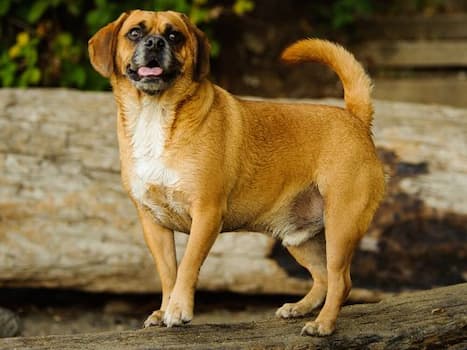Puggle Dog Breed Introduction
Puggle is a hybrid dog attained by crossbreeding a pure Pug and a Beagle. They are small to medium-sized dogs first bred in the United States in the 1990s with friendly and outgoing personalities. Puggles make good family companions with children and other pets. They have a short, smooth, and glossy double coat.
Puggles are intelligent but can be stubborn while training thus requiring patient and consistent training. They may have a wrinkled forehead, black mask, and curled tail of the Pug depending on the traits earned from the parent. Puggle loves to play fetch and go for walks. In addition, a pug’s muzzle is blunt and very short while a Beagle’s has a normal nose. After the two are crossbred, the Puggle gets a snout longer than the Pug which reduces breathing problems.
Origin | History
Puggle Lifespan

Average Lifespan for Female and Male Puggles
Overweight Lifespan
Puggle Grooming
Puggles have a short, smooth, glossy double coat that requires minimal brushing once a week. However, they will shed some hair moderately year-round. When brushing, use a medium-bristle brush or a hound glove to get rid of loose hair and promote new hair growth. Puggles are not bathed often unless they roll in something stinky or have an odor. Bathing should be done using warm water, a canine-formulated shampoo, and a conditioner.
Their nails should be cut after three to four weeks by using nail clippers as overly long nails can cause discomfort. The areas that have skinfolds on the face should be cleaned with a damp cloth. Clean their nose with a damp cotton. To avoid tartar buildup and gingivitis the Puggle’s teeth are cleaned using a brush and a canine-formulated toothpaste two to three times a week. Clean their ears with a damp cotton ball soaked in an ear cleanser to remove dirt and wax.
Puggle Coat Type and Shedding
Puggle Hypoallergenic
Puggles, a crossbreed between Pugs and Beagles, are often considered as a family-friendly and low-maintenance pet option. However, it is important to note that Puggles cannot be classified as hypoallergenic despite their moderate shedding. As they shed, they tend to leave dander around the house, which contains an allergenic protein. This protein has the potential to trigger allergic reactions in individuals who are sensitive to it. Additionally, the saliva, urine, and mucus of the Puggle also contain this protein allergen.
Therefore, individuals and families with dog allergies should exercise caution when considering Puggles as a pet option. It is recommended that they consult with a qualified veterinarian or allergy specialist to determine the best course of action. In conclusion, while Puggles may seem like an attractive pet option, it is important to be aware of their potential allergenic properties before making a decision.
Puggle Allergies
Puggles may suffer from skin allergies, food allergies, and environmental allergens. Skin allergy is caused by fleas, food allergies, and environmental allergens. They then develop symptoms including:
- Itchiness.
- Hives.
- Swelling of the ears, lips, face, eyelids, or earflaps.
- Red, inflamed skin.
- Diarrhea.
- Vomiting.
- Sneezing.
- Itchy ears.
- Chronic ear infections.
- Itchy, runny eyes.
- Constant licking.
Puggle Training
Puggles are known to be intelligent dogs and relatively easy to train. However, they can be stubborn at times thus they require training which begins at six weeks. Socializing Puggles is crucial to help them feel at ease with people, animals, places, and activities. Puggles should be introduced to socialization from three to 16 weeks by taking them to parks, around various people, other animals, smells, experiences, and sounds like lawnmowers, doorbells, and washing machines.
Using harsh words to the dog will shut down their attentiveness when training. Puggles should be enrolled in puppy classes from the age of eight weeks to enable them to socialize with other dogs. The training sessions should be limited to 10-15 minutes to prevent Puggles from losing focus. Ensure they learn command words one at a time like heel, come, lie down, or run to avoid confusion. Puggles require a 30-minute walking exercise a day. Trainers use treats, toys, and verbal praise to encourage positive behavior in Puggles. In addition, effectively housebreak Puggles by potty training, crate training, and creating a feeding schedule.
Training Tips
- Make the reward worthwhile.
- Train little and often.
- Have consistency and patience in training.
- Avoid lengthy hours of training.
- Play with the Puggle.
- Avoid punishing the dog.
- Go with the Puggles phase.
- Set the Puggle for success.
Puggle Temperament and Personality Traits
- Energetic.
- Social.
- Playful.
- Adorable.
- Affectionate.
- Protective.
- Adaptable.
- Trainable.
- Energetic.
- Friendly.
Exercise
Barking
Height
Weight
Puggle Health Issues
Puggle Names
- Lancelot.
- Ryder.
- Vulcan.
- Boo.
- Buddy.
- Skylar.
- Crystal.
- Otis.
- Percy.
Puggle Breeding
Puggles go through two heat cycles per year, which on average occurs every 5 to 11 months. Depending on their breed and size, Puggles may be ready for mating as early as six months old. Moreover, most owners will tend to wait for the Puggles to be more physically and mentally mature enough to cope with having puppies before mating occurs most likely in the second heat cycle. During their heat cycle, Puggles will display a bloody vaginal discharge that usually lasts between 14 and 21 days. This discharge indicates that the female dog’s hormone levels are changing, making her ready for fertilization.
Also, their genitals become swollen indicating to be on heat. Puggles are most fertile between days 10 and 14 of their heat cycle. To determine if their Puggle is fertile, owners can conduct two tests: a vaginal smear test and a blood test. For the dogs that are new to each other, let them meet a few days before the mating day. Breeders or owners should keep the environment calm. After ejaculation, the two dogs may become physically locked together in a “breeding tie,” which is a sign of successful mating in dogs.
In case a breeding tie happens, let the owners or breeders calm down the dogs until the period is over. If the mating is successful, the female dog will show signs of swollen mammary glands, sleep more and lose her appetite. These symptoms indicate that the dog is pregnant.
Puggle Colors
Puggles are available in Black, fawn, red, tan, and lemon colors. When a black pug crossbreeds with a beagle, there is a possibility of attaining black Puggles.
Tail
Puggles have a curled tail earned from the pug’s side. Their tail curls due to spinal deviation, available at the wedge-shaped lower vertebrae to the bone and cartilage of the tail.
Teeth
Puggles have 42 teeth with 20 on top and 22 on the bottom jaw. They also use their teeth as weapons and as tools for cutting or tearing food.
Puppy
The gestation period of puggles is approximately 63days. Healthy puggles have an average of six puppies. The puppies have the traits of the breeding parents. They may have a wrinkled forehead, black mask, and curled tail.
Puggle Muzzle
Puggles are small to medium-sized animals. Thus, the muzzle size should be approximately 1/2 inch or 1 inch to 1 1/2 inch to the dog’s exact circumference of the snout.
Puggle Food
The amount of food Puggles take depends on their activity level, size, metabolism, and body build. Puggles should feed on small-sized dog food appropriate for their age if they are puppies, adults, and seniors. These dogs eat homemade, raw food, and commercial food either wet or dry. Moreover, the Puggles are prone to weight gain like their breeding parents. Thus, they should eat twice a day in the morning and evening.
However, the puppies have a higher metabolism than adult Puggles and an extra meal is given during the day. To avoid pet obesity, consult with the vet for the best daily feeding guide. Treats given should be also moderated and avoid feeding the dog with high-fat food. Additionally, provide the dogs with clean water at all times.
Food Obsession
The Puggle breed parents, the Pug and Beagle are known to be food-obsessed dogs. Thus, ensure you give a specified amount of food and also educate them that their food only comes from their food bowl.
Apart from Puggles, other dog breeds include:
Puggle Price
The price of a full grown Puggle ranges from $1100 to $2500 depending on the proximity of the breeder, age, and pedigree.
Pug Puppies Prices
The cost of a pug puppy ranges from $800 to $2000 depending on the months of the puppies and the location.
Puggles Are The Worst
Puggles are said to be worse due to their challenges based on their cons. The cons include:
Stubbornness -which contributes to the independent nature of the beagle.
Energy Levels – if not adequately addressed through regular exercise and mental stimulation, energy levels could lead to undesirable behaviors.
Separation Anxiety – It is not easy to separate once they bond with the owners. If separation anxiety is not addressed, the dog will have behaviors like excessive barking, destructive chewing, or attempts to escape.
Health Expenses – they have potential health-related expenses associated with this crossbreed.
Shedding – Puggles tend to shade due to the inherited coat, making it hard for people with allergies to deal with their hair.
Flatulence – Puggles can be prone to swallowing air while eating contributing to increased flatulence.
Snoring – The dog can inherit certain anatomical features from their Pug parent such as a brachycephalic facial structure which will result in a compressed airway leading to snoring.
Frequently Asked Questions:
What Is A Puggle
How Big Do Puggles Get
Puggles are small to medium-sized dogs that weigh 15 to 30 pounds ( approx. 6.8 kg to 14kg ) and stand at 12–15 inches ( approx. 30 to 38 cm ).
How Long Do Puggles Live
How Much Are Puggles
What Breed Of Dog Is A Puggle
Are Puggles Good Dogs
Yes. They are said to be good dogs due to being sociable and friendly mostly with children and other pets. They are also good walking companions.
How Much Do Puggles Weigh
A healthy Puggles weighs 15 to 30 pounds ( approx. 6.8 kg to 14kg ).
Do Puggles Shed
Yes. Puggles shed a lot since they are double-coated and lose the undercoat in Spring and Fall when preparing for seasonal change. During this period, they require brushing at least once a week to rid of their excess coat.
What Do Puggles Usually Die From
Puggles Quick Facts
- Puggles love to be the center of attention.
- Prone to being obese or overweight.
- They suffer from some eye conditions, including “cherry eye” and progressive retinal atrophy.
